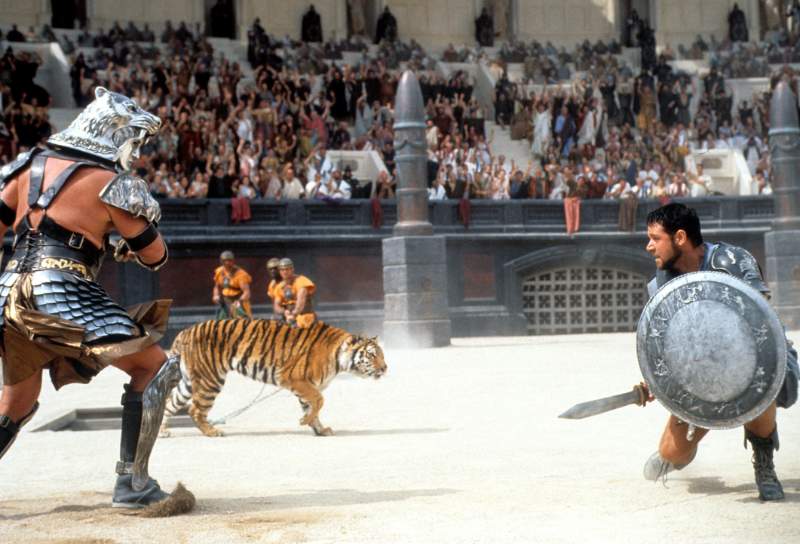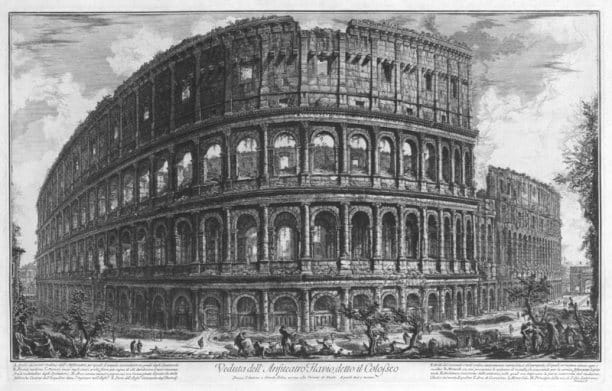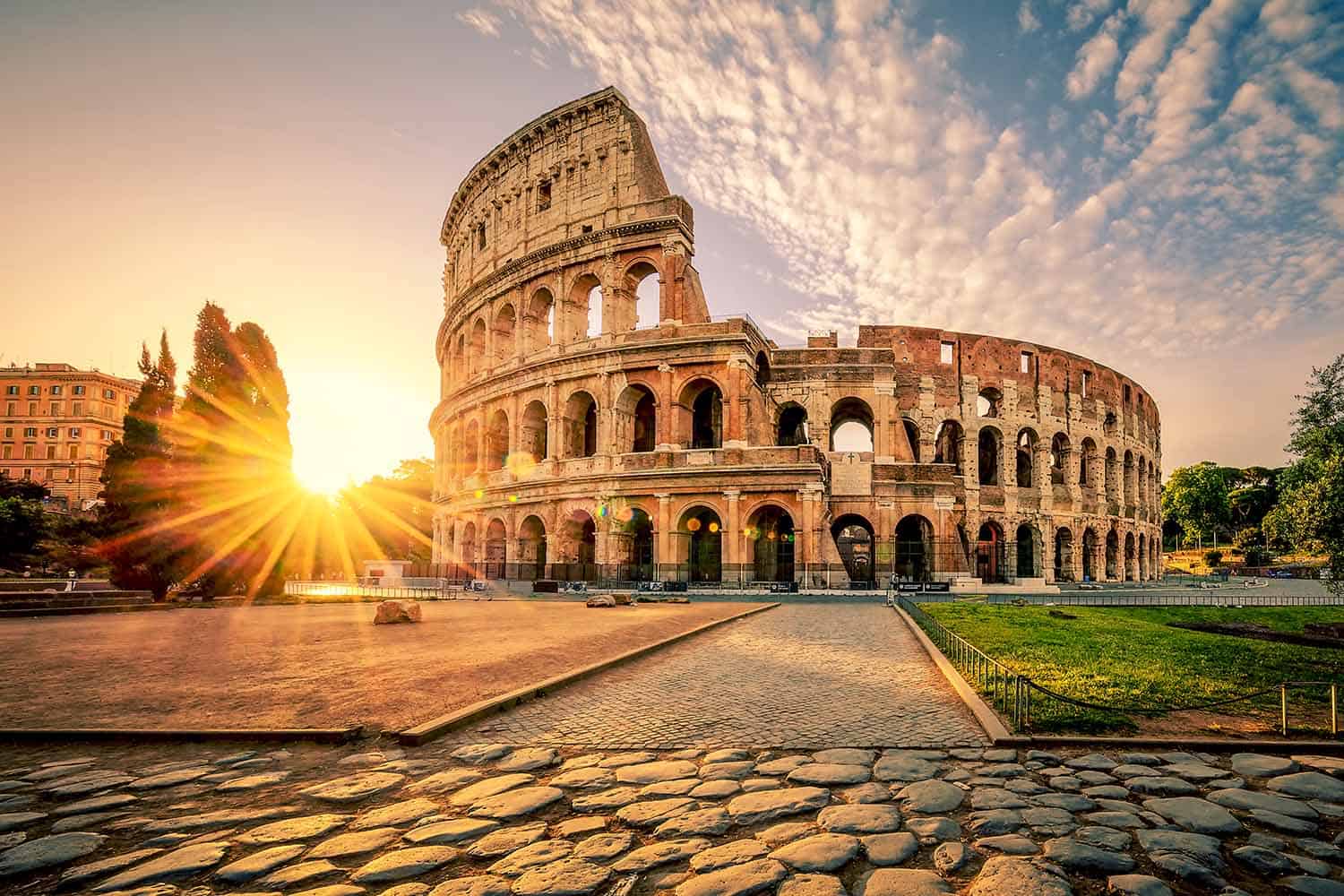Rome has numerous world-famous attractions, many commemorating the time of the Roman Empire. The most famous landmark may be the Colosseum as it brings so much history that many people all over the world are at least somewhat familiar with.
However, visitors soon discover that the Colosseum is now a worn structure.
The Colosseum’s current state can only be defined as broken, and there are several reasons for this besides the natural decline from time:
- Much of the Colosseum’s stone was used to create new structures in the city
- An earthquake in the 7th century destroyed part of the Colosseum
Overall there is not one reason why the Colosseum is broken now and only shows a bit of its lost beauty, many factors over the course of history have caused it to lose some of its luster, but that has not lessened the Colosseum’s continuing appeal. Keep reading to learn more about this famous structure and its current broken state.
Table of Contents
Why Is the Colosseum Famous?
In modern media depicting the Roman Empire, it seems that it is almost impossible to show Rome in its prime without showing the Colosseum. The Colosseum’s connection to the empire that helped shape much of the history of the Western world and its impressive architecture have given the broken building a lasting place in modern times.
With everything the Romans built, why is the Colosseum particularly so famous? We often connect the Colosseum with gladiator fights. Gladiators were slaves, and typical gladiator fights pitted these men against wild animals as well as fellow fighters. It was a spectacle that the Roman crowds flocked to much as we now attend sporting events.
Are the gladiators the reason the Colosseum is famous then? Actually, the Colosseum was not the only place in Rome to hold gladiator fights. Other cities also had large outdoor amphitheaters where fights were held. Why then is it the Colosseum that is so famous?
The secret to the Colosseum’s fame is scale. Other cities may have had places to hold gladiator fights and other events, but none of them rivaled the magnificence and size of the Colosseum. Think of the difference between your high school sports stadium and a professional sporting arena, except this arena was built by hand almost 2000 years ago.
In its prime, the Colosseum truly was grand. There were awnings that could be let out to provide shade, a series of underground corridors and trap doors to allow sudden entrances into the arena, and even a system that flooded the Colosseum for naval battles! The Colosseum is a building that embodies the Roman empire at its height.
Famous movies that have used the Colosseum in them.
The Colosseum, an iconic symbol of Ancient Rome, has served as a backdrop for numerous films over the years. One of the most iconic movies that prominently feature the Colosseum is Ridley Scott’s “Gladiator” (2000), where Russell Crowe’s character, Maximus, fights for his life and honor in its grand arena. Similarly, the Colosseum plays a significant role in the 1951 film “Quo Vadis,” which depicts the early Christian community in Rome. The majestic ruins have also made appearances in lighter fare such as “Roman Holiday” (1953) starring Audrey Hepburn and Gregory Peck, even if just in passing shots that help capture the essence of Rome.

What Was the Purpose of the Colosseum?
As stated above, the most obvious answer is that gladiatorial matches were held in the Colosseum, but to say the purpose of the Colosseum was merely just for hosting these events is a bit too simple of an explanation. The Colosseum was an entertainment venue, and there was more going on than gladiatorial matches.
While the gladiatorial matches were the most popular, and some involved wild animals, there were also specific hunts where there were rewards for the hunters who got the biggest kills. Public executions were also held regularly.
Besides the bloody events, there was also a large element of theater in the Colosseum. Moments in history and even events that took place at sea were portrayed by large casts with very impressive props. This kept the population informed about notable events in Roman history.
The Colosseum was also a way to show the riches of the empire and its far-reaching influence. Those who fought in the battles at the Colosseum (both people and animals) were imported from all reaches of the empire which stretched all over Europe and Northern Africa.
Thus, the Colosseum was for entertainment and grand displays, but why was this so important to the Roman culture? Roman leaders believed that it was important to provide people with an outlet. Entertained people are far less likely to rebel, and the show of the Colosseum also assured the people of their empire’s strength and success.
Still, we cannot go so far as to assume that the Colosseum was secretly a government conspiracy to keep people happy and docile. Just as we today enjoy concerts, sporting events, movies, and other entertainments in large settings, the Romans also enjoyed their entertainment.
Who Built the Colosseum and Why?
The building of temples, monuments, and other large projects was a common pastime of Roman Emperors. Building impressive structures was a way to fully display the strength and wealth of Rome. The Colosseum was one of many such building projects, but there is a bit more to the story behind its construction.
The construction and location of the Colosseum owe themselves to a Roman political dispute. Nero, the fifth Roman empire, had a very high opinion of himself. He thought of himself as a god. Taking advantage of every opportunity that was given to him, he took a lot of the land from the city after the Great Roman fire of 64 AD.
Nero was not a popular emperor. When Nero died some landmarks in commemoration of him remained in the area he took from the city, but the Colosseum was chosen as a way to build something for the people in this area as a way to symbolically give the Roman people the city back in a sense.
After the First Jewish Roman War in 70 AD, there was extra money in Roman coffers, and Emperor Vespasian began the construction of the Colosseum. The construction was done by slaves and prisoners of war generally and was finished in 80 AD by Titus, the son of Emperor Vespasian.
As a project, the Colosseum was a great public relations move for Emperor Vespasian and his son Titus. It was an impressive structure that marked the success of Vespasian, while at the same time distancing him from his much-disliked predecessor, Nero. It was also a marker of military success since it was built using spoils from war.

Have attempts been made to repair the Colosseum?
Yes, there have been several attempts to repair and restore the Colosseum over the centuries. Given its historical significance and role as a major tourist attraction, preservation efforts have been paramount. In the 19th century, stabilization efforts were initiated to prevent further decay and damage. In more recent years, a major restoration project, funded by private sponsors, began in 2013 to clean and restore the façade of the Colosseum, strengthen its structure, and improve visitor amenities. This was one of the most comprehensive restorations the monument has ever received. As a result of these efforts, parts of the Colosseum previously closed to the public have been reopened, ensuring the continued appreciation of this ancient marvel for generations to come.
Here’s a table summarizing the various attempts and renovations that have been made to repair the Colosseum:
| Year | Description |
|---|---|
| 70-80 AD | Construction of the Colosseum, originally known as the Flavian Amphitheatre, completed. |
| 217 AD | Damaged by fire, repairs were made to the structure. |
| 443 AD | Severe earthquake caused significant damage, with some repairs undertaken. |
| 523-524 AD | Another major earthquake further damaged the Colosseum, leading to additional repair efforts. |
| 12th Century | Much of the Colosseum’s stone was removed for construction materials, leading to further deterioration. |
| 18th Century | Various restoration efforts initiated by popes to preserve the Colosseum as a historic site. |
| 1930s-40s | Extensive restoration work carried out, focusing on the outer facade and structure. |
| Ongoing | Continuous efforts to preserve and maintain the Colosseum for both historical and tourist purposes. |
Can You Go Into the Colosseum?
Italy, Rome specifically, is one of the most visited tourist sites in the world. The Colosseum is one of the most visited tourist sites in Rome and Italy and welcomes millions of visitors each year.
Visitors to the Colosseum have numerous options when it comes to seeing it, they can go on guided tours, audio tours, or just explore on their own. During different seasons there is some programming around the Colosseum that also interests tourists.
The Colosseum is massive. It could hold around 50,000 spectators in its prime. If you do visit it will take you some time to fully explore this large structure. However, because of its current broken state, you can not examine every corner of the Colosseum. Many places are no longer accessible or safe, so visitors should always follow guidelines.
Still, there remains a lot to see even now. The Colosseum has a lot of different sites within its grounds. Here are some things visitors should be sure to see.
- The Outer Ring – The Outer Ring is probably the picture you have in your head when you think about the Colosseum. It consists of three rows of stacked arches that support the Colosseum’s main feature: the seating.
- Flavian Amphitheater Plaque – If you keep your eyes open you can see this plaque on the Outer Ring. It marks the true name of the Colosseum: the Flavian Amphitheater. In truth, Colosseum is just a nickname!
- The Cross – If you are interested in the history of the Colosseum, you may find the cross that was erected in 2000 worth a look. The cross was built as a monument to all the Christian martyrs that died in the Colosseum. It is a reminder that this place was the site of many executions.
- Gate of Death – Walking through the Gate of Death is sure to be a surreal experience. This gate is where wounded and dead were taken out of the Colosseum.
- Arena Floor – If you want to stand where the action took place, you will need to get a special pass to visit the arena floor. This is where you can experience what a gladiator would have seen.
- Underground – There is more to the Colosseum than the arena and spectator seats. Under the Colosseum is a complex system of tunnels. The Underground can be visited today and is where organizers prepared for events and released people and animals onto the arena floor.
- Emperor’s Seat – There are a lot of seats in the Colosseum, but visitors should keep an eye out for the Emperor’s seating area. Where you sat was a mark of status, so it is worth checking out where the most important man in the empire sat.
- Ludus Magnus – This was a gladiator training school located directly across from the Colosseum. When you visit you can see the cells where slaves were kept. The Ludus Magnus even had a tunnel that connected it directly to the Colosseum. It is worth touring as it is very much a part of the Colosseum’s history.
Even if you are trying to do Rome in three days, the Colosseum is definitely a place that you need to visity!
The Colosseum as a Wonder of the World.
The Colosseum, also known as the Flavian Amphitheatre, is often listed as one of the “New7Wonders of the World,” a testament to its enduring architectural and cultural significance. Constructed in 80 AD, it was the largest amphitheater of the Roman Empire and could hold up to 80,000 spectators. It showcased grand gladiatorial contests, mock sea battles, animal hunts, and other forms of entertainment. Beyond its historical importance, the Colosseum represents the epitome of Roman engineering and design. Even in its partially ruined state, it stands as a testament to the grandeur and sophistication of Ancient Roman civilization, drawing millions of tourists annually, all eager to experience a tangible connection to antiquity.
How Many People Died in the Colosseum?
Contrary to popular belief, not all gladiator fights ended in death. Fights were simply until one gladiator was incapacitated. The Emperor then signaled to the winner whether they should spare or finish their opponent, often with some input from the crowd.
Still, even though every fight did not end in death, enough of them did for those deaths to add up over time. Besides the Colosseum was also home to executions and hunts or fights involving wild and exotic animals.
It is generally estimated that between the slaves, gladiators, convicts, prisoners, and other entertainers around 400,000 people died in the Colosseum’s four centuries of use. This number does not include the many animals that also died in the arena.
Conclusion
The Roman Colosseum has one of the most complicated legacies of all buildings around the world. It represents the greatness of the Roman Empire with its architecture, scale, and grandiose events. However, it also represents a society that killed hundreds of thousands to entertain its subjects.
Today, the Colosseum retains much fame around the world. For historical interest, millions go to see the remains yearly. While we still celebrate some things about the building, we now also recognize its horrors. It remains a place with a conflicted legacy.
(If you are looking to visit the Colosseum, you will need a place to stay. Check out the 10 best Airbnbs in Rome! Or you can get an all inclusive experience with these Airbnb experiences in Rome!)


